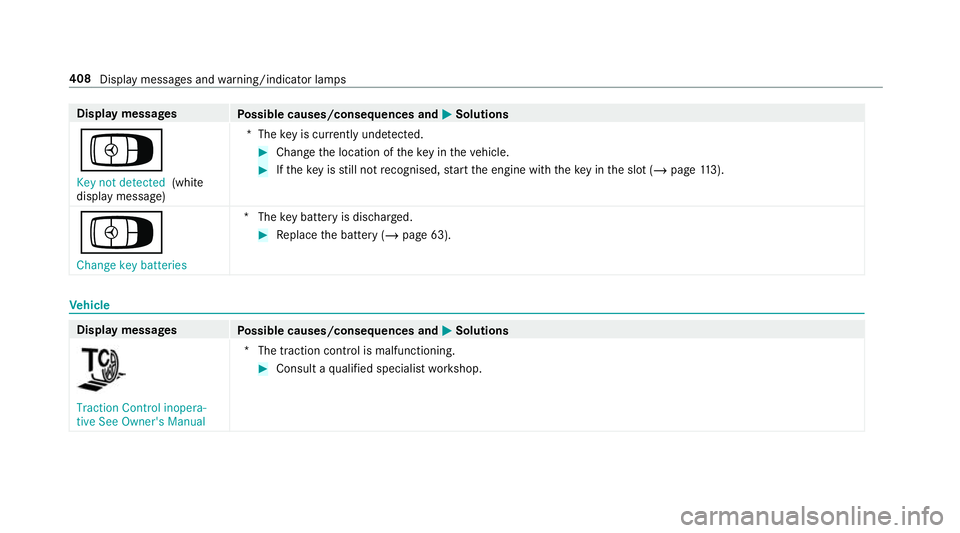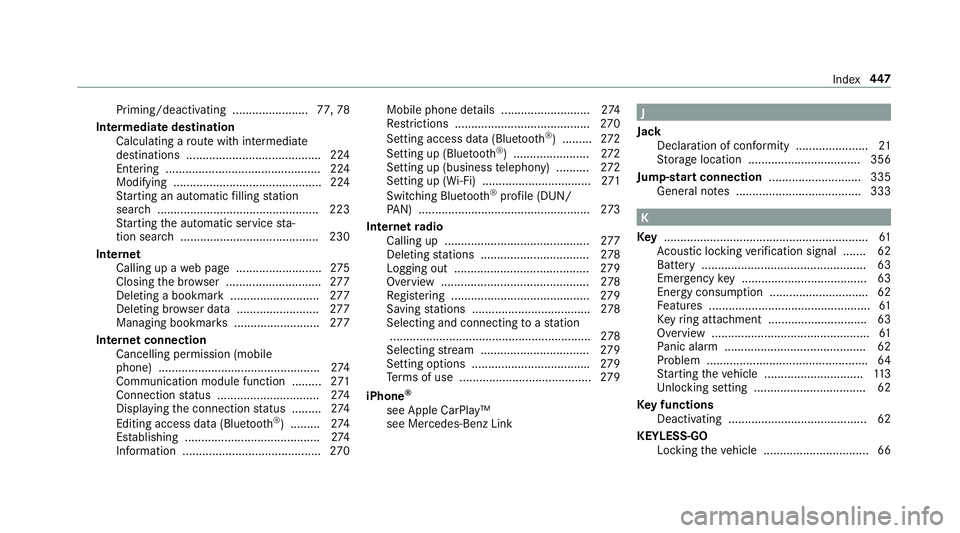2018 MERCEDES-BENZ AMG GT R-ROADSTER battery location
[x] Cancel search: battery locationPage 27 of 473

of an accident,
rescue services can use the QR
code toquickly find the appropriate rescue card
fo ryo ur vehicle. The cur rent rescue card con‐
ta ins the most impor tant information about your
ve hicle in a compact form , e.g. thero uting of the
electric lines.
Fu rther information can be obtained at http://
www.mercedes-benz.de/qr-code. Data
storage Electronic control units
Elect
ronic control units are fitted in your vehicle.
Some of these are necessary forth e safe opera‐
tion of your vehicle, while some assist you when
driving (driver assis tance sy stems). In addition,
yo ur vehicle pr ovides com fort and enter tainment
functions, which are also made possible byelec‐
tronic control units.
Elect ronic control units contain da tamemories
which can temp orarily or permanently store
te ch nical information about theve hicle's operat‐
ing state, component loads, main tenance
re qu irements and tech nical events or faults. In
general, this information documents thest ate
of a component part, a module, a sy stem or the
sur roundings such as:
R operating status of sy stem components (e.g.
fi ll le vels, battery status, tyre pressure)
R status messages concerning theve hicle or
its individual components (e.g. number of
wheel revo lutions/speed, longitudinal accel‐
eration, lateral acceleration, display of fas‐
te ned seat belts)
R malfunctions or faults in impor tant sy stem
components (e.g. lights, brakes)
R information on events leading tovehicle
damage
R system reactions in special driving situations
(e.g. airbag deployment, inter vention of sta‐
bility control sy stems)
R ambient conditions (e.g. temp erature, rain
sensor)
In addition toprov iding the actual control unit
function, this data assists the manufacturer in
de tecting and rectifying faults and optimising
ve hicle functions. The majority of this data is te
mp orary and is only processed in theve hicle
itself. Only a small portion of the data is stored
in theeve nt or fault memor y.
When your vehicle is serviced, tech nical da ta
from theve hicle can be read out byservice net‐
wo rkemplo yees (e.g. workshops, manufactur‐
ers) or third parties (e.g. breakdown services).
Services include repair services, maintenance
processes, warranty claims and quality assur‐
ance measures, forex ample. The read out is per‐
fo rm ed via the legally prescribed port forthe
diagnostics connection in theve hicle. The
re spective service network locations or third
parties collect, process and use the data. They
document tech nical statuses of theve hicle,
assist in finding faults and impr oving quality and
are transmitted tothe manufacturer, if neces‐
sar y.Fu rthermore, the manufacturer is subject
to product liability. Forth is, the manufacturer
requ irestech nical da tafrom vehicles.
Fa ult memories in theve hicle can be reset by a
service outlet as part of repair or maintenance
wo rk. 24
General no tes
Page 411 of 473

Display messages
Possible causes/consequences and M
MSolutions
Á Key not detected (white
display message) *T
hekey is cur rently und etected. #
Change the location of theke y in theve hicle. #
Ifth eke y is still not recognised, start the engine with theke y in the slot (/ page113).
Á Cha nge key batteries *T
hekey bat tery is dischar ged. #
Replace the battery (/ page 63).Ve
hicle Display messages
Possible causes/consequences and M
MSolutions Traction Control inopera-
tive See Owner's Manual
*T
he traction contro l is malfunctioning. #
Consult a qualified specialist workshop. 408
Display messages and warning/indicator lamps
Page 450 of 473

Priming/deactivating .......................
77,78
Intermediate destination Calculating a route with intermediate
destinations ........................................ .224
Entering ............................................... 224
Modifying ............................................. 224
St arting an automatic filling station
sear ch................................................. 223
St arting the automatic service sta‐
tion sear ch.......................................... 230
In tern et
Calling up a web page .......................... 275
Closing the br ows er ............................. 277
Del eting a bookmark .......................... .277
Del eting br owser data .........................2 77
Managing bookmar ks.......................... 277
Internet connection Cancelling permission (mobile
phone) ................................................ .274
Communication module function ........ .271
Connection status .............................. .274
Displ aying the connection status ........ .274
Editing access da ta(Blue tooth ®
) .........2 74
Es tablishing .........................................2 74
Information ..........................................2 70Mobile phone de
tails .......................... .274
Re strictions ......................................... 270
Setting access da ta(Blue tooth ®
) .........2 72
Setting up (Blue tooth®
) .......................2 72
Setting up (business telephony) .......... 272
Setting up (Wi-Fi) ................................. 271
Switching Blu etoo th®
profile (DUN/
PA N) .................................................... 273
Internet radio
Calling up ............................................ 277
Del eting stations ................................ .278
Logging out .........................................2 79
Overview ............................................. 278
Re gis tering .......................................... 279
Saving stations .................................... 278
Selecting and connecting toast ation
............................................................ .278
Selecting stre am ................................ .279
Setting options ................................... .279
Te rm s of use ........................................2 79
iPhone ®
see Apple CarPlay™
see Mercedes-Benz Link J
Jack Declaration of conformity ..................... .21
St orage location ..................................3 56
Jump-start connection ............................ 335
Gene ral no tes ...................................... 333 K
Ke y.............................................................. 61
Ac oustic locking verification signal ....... 62
Battery .................................................. 63
Emer gency key ...................................... 63
Energy consum ption .............................. 62
Fe atures ................................................ .61
Ke yring attachment .............................. 63
Overview ................................................ 61
Pa nic alarm ........................................... 62
Problem ................................................ .64
St arting theve hicle .............................. 11 3
Un locking setting .................................. 62
Ke y functions
Deactivating .......................................... 62
KEYLESS-GO Locking theve hicle ................................ 66 Index
447